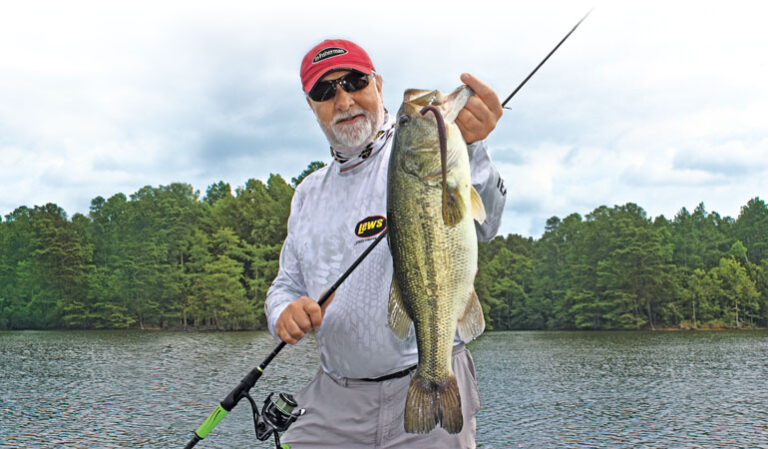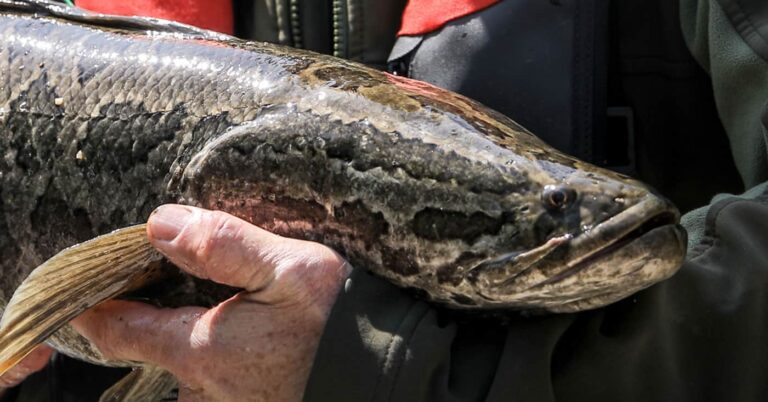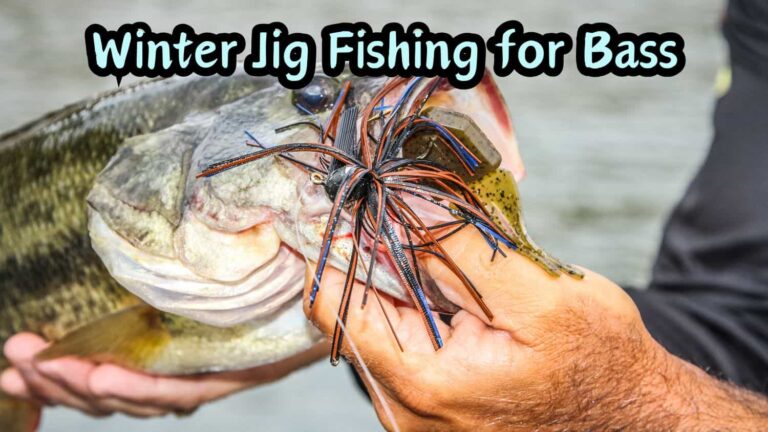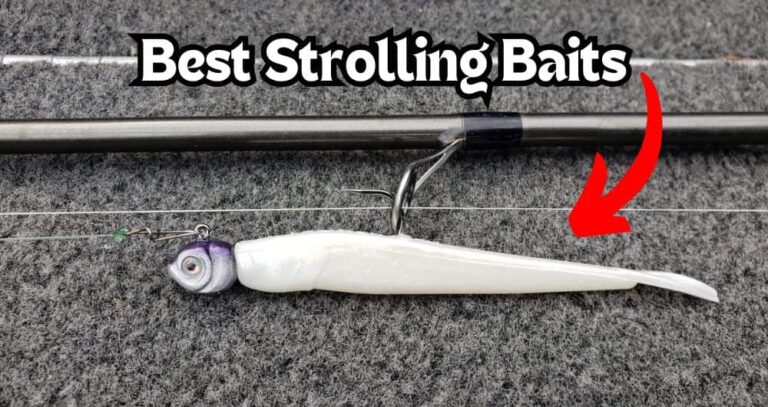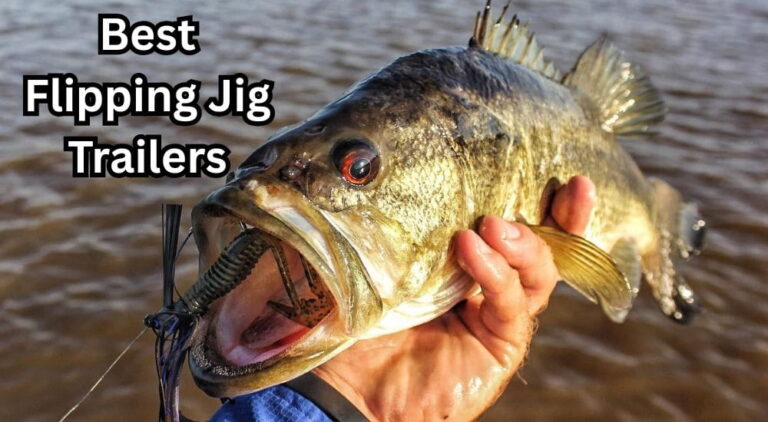Best Bass Lures for Pond Fishing
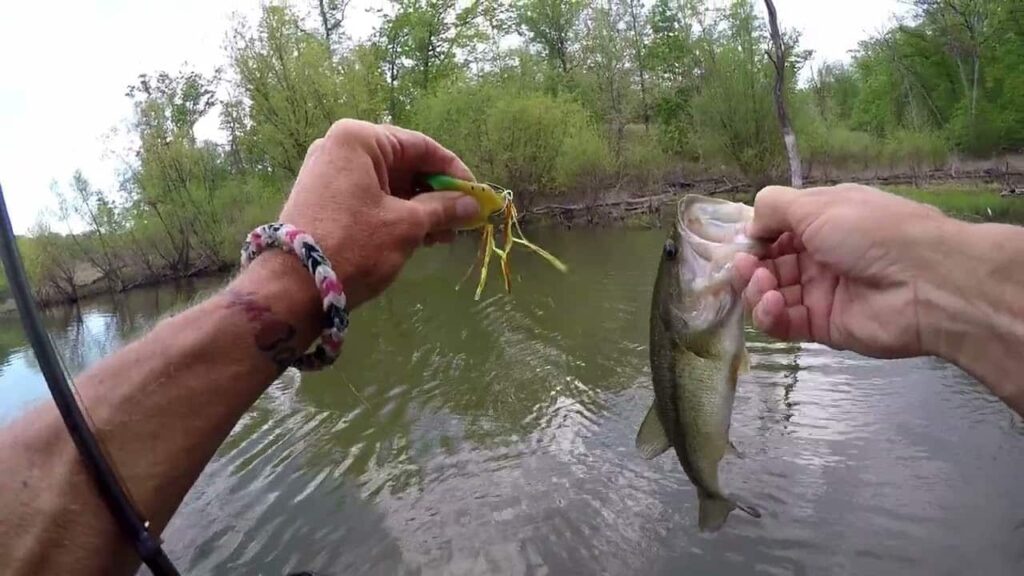
As much as you see videos of fisherman on their expensive bass boats and tricked out kayaks, the reality is that most fisherman spend their fishing days on the banks of small ponds.
And many of the lures and techniques that work so well on huge lakes don’t quite translate to a pond. So what are the best bass lures for pond fishing?
Best Overall Bass Lures for Pond Fishing
If I could only choose a handful of lures in order to catch pond bass all year, these are ones I would choose.
I will breakdown the best pond lures for spring, summer, fall, and winter later in this article.
1. Swim Jig
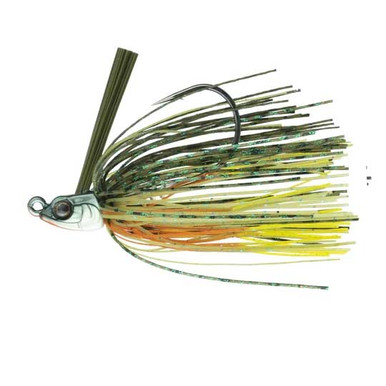
Everyone knows how great jigs are for catching bass. When it comes to pond bass fishing, I almost exclusively use swim jigs because of their versatility.
You can fish swim jigs fast or slow. You can flip, pitch, drag, or punch them as well.
With a red or brown color, you can hop a swim jig on the bottom and mimic a crawfish.
Swim a green or brown one and you mimic a bluegill. And a white swim jig is a great shad imitation.
You can really fish a swim jig so many ways in order to match the hatch.
And because of the thick weed guard that comes on all jigs, they are incredibly weedless.
This is even more important when pond fishing, because you can’t just drive your boat over to the snag and get your lure back.
2. Wacky Rig
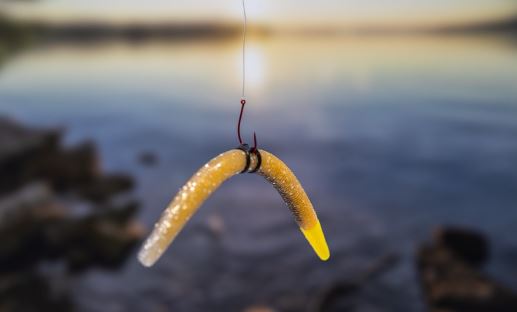
I don’t know what it is about the wacky rig in ponds, but it out fishes pretty much everything else.
You can really never go wrong with a finesse bait when fishing ponds.
The slow sinking nature of the wacky rig allows you to control it’s depth very easily and keep it out of the weeds and algae that take over many ponds.
When I was a kid, I rarely tied on anything other than a wacky rig during the summer months.
When the weather got very warm, bass just didn’t seem to want anything else.
The only problem with the wacky rig is that lots of smaller bass will eat it before the big ones get a chance.
3. Square Bill Crankbait
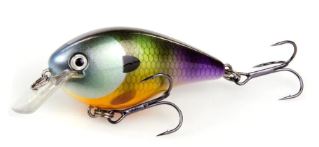
Crankbaits are tremendous bass lures, and square bills are often the only crankbaits that you can use in a shallow pond.
Other crankbaits will either dive too deep or sink down into the algae and pond scum.
But a square bill crankbait only dives 2-4 feet deep, so you don’t have to worry about digging into the bottom and picking up weeds or snagging.
I really love fishing a square bill during the post-spawn and fall times of the year.
Crankbaits are loud and put off tons of vibrations, which is great for ponds that muddy up easily.
Also Read: Squarebill Fishing in Fall Ponds
4. Spinnerbait
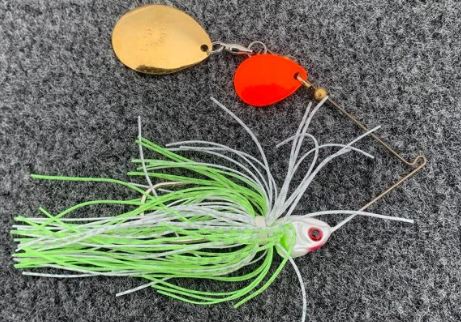
No matter what body of water you are fishing, you need to have some kind of bladed lure in your rotation.
The flash, vibration, and sound that a thin, metal blade puts of in the water triggers tons and tons of bites.
I can’t give a scientific reason as to why, but I have found that spinnerbaits are the best bladed lure option for pond bass fishing.
I have fished all over the country, and spinnerbaits just always seem to out perform other flashy lures like chatterbaits or underspins.
A spinnerbait will catch pond bass any time of year except for the winter.
I throw it from pre-spawn all the way into the late fall months. The spinnerbait is a classic lure that never fails to catch bass.
5. Hollow Body Frog
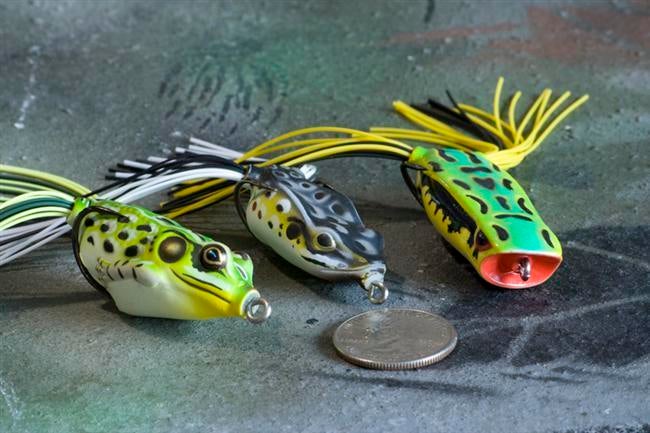
When it comes to ponds, they often are very shallow and infested with thick vegetation.
Whether it is lily pads, hydrilla, thick algae, or matted grass, you need to be able to fish in and around this vegetation without getting hung up.
The hollow body from is the most weedless, snagless lure possible. You can fish it right over top of all this green debris without skipping a beat.
And with all the frogs, lizards, bluegill, and other creatures up on the surface during the spring and summer, a hollow-body frog is actually very realistic.
The frog is also one of my favorite lures for specifically catching bigger bass in ponds.
Let’s Get A Little More Specific
The five lures listed above are my go-to lures if I could only choose a handful.
But that doesn’t mean that they are the best choices 100% of the time.
Spring Pond Lures

Also Read: Best Lures for Pond Bass in Spring
1. Tokyo Rig
I believe that the Tokyo rig is very underrated in the fishing community.
Part of this is probably because the pro anglers that promote baits are never fishing small ponds.
The Tokyo rig is essentially a compact, power version of the drop shot.
You are able to fish a free swinging soft plastic 2-3 inches off the bottom at any speed you like.
This versatility allows you to fish many types of soft plastic baits such as craws, worms, or my favorite, paddle tails.
During the pre-spawn, I love to slow roll a paddle tail on a Tokyo rig.
The weighted wire keeps the swimbait just above the bottom and right in the view of hungry bass.
2. Jerkbait
Whenever the water temperatures are cold, the jerkbait is going to be one of your best options.
When fishing a pond in the spring time, you want to choose a silent jerkbait.
The loud rattles can be heard all the way across these small bodies of water and tend to make bass apprehensive in cold water ponds.
Also, consider adding a feather to the back hook of your jerkbait. Lots of fisherman use these lures during the springtime, so the feather can differentiate your lure from the rest.
3. Spinnerbait
If I was fishing a big lake or reservoir in the spring, I would lean towards the chatterbait.
But in ponds, I catch many more bass on the spinnerbait. I really like a white or red spinnerbait.
The bluegill still aren’t super active yet, so I’m more trying to imitate shad or crawfish.
When it comes to blade selection, a single Colorado blade is best choice.
You can retrieve the bait a bit slower and still get the blade spinning.
The Colorado blade puts off more of a thumping vibration that works great in the spring.
Summer Pond Lures

1. Frog
The frog is an obvious choice for summer pond fishing. It is imperative that you are able to fish through vegetation in the summer.
Summer ponds get very warm. So bass seek out shade in the form of grass or structure.
If you can’t get your lure right into the thick of this vegetation, you are missing out on tons of bass that are hungry and looking to eat.
The frog is the only lure that allows you to fish right in the heart of the toughest cover.
2. Weightless Senko
During the dog days of summer, ‘the weightless Senko is hard to beat. It is weedless and almost too simple to be true.
You literally just let it sink and then pull and pop it off of the bottom It doesn’t really have any action, but that is why it gets so many bites.
The Senko is so non threatening that bass can’t help but to bite it. If you are having a hard time getting a bite during the hot summer, tie on a weightless Senko.
3. Bluegill Swimbait
During the warm months, pond bass are primarily feeding on bluegills. So logically, you can’t go wrong imitating bluegills.
And no lure does a better job of this than a bluegill swimbait.
I personally prefer the hard-body, jointed swimbaits more than soft plastic ones, but that is more of a personal preference.
Bluegill swimbaits work best along weed lines or depth changes where bass are cruising.
My favorite time all year to fish these lures is during the bluegill spawn.
Bass just sit and wait for bluegill to drift a little too far off of their bed, and then the bass attack.
Throwing a bluegill swimbait just outside of these beds catches me huge bass every yeat.
Fall Pond Lures

1. Spinnerbait
When I think if fall pond fishing, the spinnerbait is the first thing that comes to mind.
As temperatures begin to fall and bass start aggressively feeding on baitfish, nothing beats a spinnerbait.
Contrary to the springtime, I will us a spinnerbait with one small Colorado blade in front and a willow leaf in the back.
This is considered the most standard spinnerbait setup. You can fish it at a variety of speeds and water depths to find exactly where the bass are.
The flash of those blades drives fall season bass crazy.
2. Walking Bait
Nothing in bass fishing is more thrilling and exciting that a bass blowing up on a walking bait.
The side-to-side darting and swimming of a walking bait on the surface is just irresistible for fall pond bass.
I like a silver or white color most of the time because I am really trying to imitate a shad darting around on the surface.
Make sure not so set the hook right away when you get a hit. Lots of times, bass will hit the bait but not actually get hooked.
So even when a bass blows up on the bait, just keep working it until you actually feel the weight of the bass, and then set the hook.
3. Square Bill Crankbait
The wide wobble and stocky shape of a square bill crankbait is perfect for the fall.
These pond bass are looking to feed up a lot, and bluegill are still a main target for them.
The body shape of square bills is exactly like a little bluegill that is still only a few months old.
You can bump this crankbait around shallow rocks and flats since much of the vegetation has begun to die off.
Winter Pond Lures

1. Ned Rig
This shouldn’t come as a surprise. The Ned rig is a top tier winter bass lure no matter what body of water you are fishing.
I either use the standard stick bait or a small crawfish soft plastic. Sometimes less is more.
This is especially true during the cold winter months. As long as you can keep the hook clean, no other lure will catch more pond bass in the winter than a ned rig.
2. Shaky Head
The shaky head is kind of like a finesse football jig. The finesse worm bends and undulates as you slowly drag the shaky head along the bottom.
The shaky head will get a little bit bigger bites than the ned rig because of it’s larger size and profile.
I mostly drag the shaky head, but if you find a piece of cover or a depth change, shake it in one place.
This keeps it in the high percentage area longer and gets more bites.
3. Jerkbait
Although I fish finesse baits almost all the time in winter, the jerkbait is the best hard bait option.
Everyone knows how good jerkbaits are for winter bass fishing. They are very realistic lures that can be suspended off of the bottom.
This allows fish to site hunt your lure much better than bottom hopping lures.
The erratic darting action of the jerkbait can still trigger reaction strikes from bass even in the cold water.
Best Lure Colors for Pond Fishing
Even if you are using the right lures, it helps a lot to select the appropriate colors as well. When it comes to pond fishing, I keep my color choices very simple.
Black
Ponds are often very muddy because of how much they are effected by rain.
When fishing a muddy pond, no color will work better than black.
The darkness creates a high contrast that allows bass to see your lure easier.
Red
Red is my favorite color to use during the winter and spring months. Bass really feed up on crawfish when the water is cold, and they hone in on the color red.
Bluegill Pattern
This is a little less specific, but it refers to colors such as green pumpkin, brown, orange, or more realistic paint jobs for clear water.
Bluegill are the number one forage of pond bass. So you need to have lure colors that imitate bluegill.
White
White is a high visibility color that works everywhere. It resembles shad very well, but even if your pond doesn’t have shad, white still produces tons of bites.
Reeling this In
While the glamour of large bodies of water may be enticing, the reality for most anglers is fishing from the banks of small ponds.
The top five bass lures for pond fishing—swim jigs, wacky rigs, square bill crankbaits, spinnerbaits, and hollow body frogs—offer versatility to match various forage throughout the year.
Specific recommendations for each season, along with considerations for lure colors like black in muddy ponds, red during colder months, bluegill patterns for imitating primary forage, and high-visibility white, provide a strategic approach.
Successful pond fishing hinges on adapting to seasonal changes and understanding the nuances of these smaller ecosystems, ensuring a rewarding angling experience.

